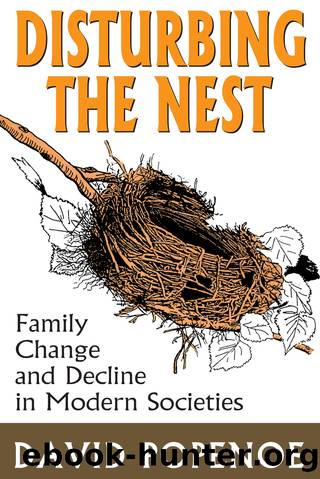Disturbing the Nest by David Popenoe

Author:David Popenoe [Popenoe, David]
Language: eng
Format: epub
Tags: Social Science, Social Work, Family & Relationships, General
ISBN: 9780202303512
Google: LeGrAAAAQBAJ
Publisher: Transaction Publishers
Published: 1988-01-15T05:04:32+00:00
The Declining Institution of Marriage
In most discussions of family decline the weak link in today's families, by almost everyone's reckoning, is the social and emotional bond between the parents. This bond is the basis on which most marriages are constituted in advanced societies. We can begin, then, with what is happening to the institution of marriage in Sweden.
It is important to differentiate the institution of marriage from the institution of the family. At heart, marriage involves a sexual union between two people. But to put the institution of marriage in context, Kingsley Davis has made a useful continuum of sexual unionsâfrom a liaison at one pole through cohabitation, consensual union, and common-law marriage to legal marriage at the other pole.1 While all of these relationships involve the expectation of sexual relations, as one moves up this continuum other elements are added to the basic sexual union. These elements are common residence (not characteristic of the liaison), a division of labor, the expectation of children, the assumption of permanence, and finally public recognition. Much nonmarital cohabitation in Sweden today has most of these elements, but marriage is the only form of sexual union that has them all. What the institution of marriage stands for, and has always stood for, is the final element added to the continuumâthe social (public, formal) approval of a union between a man and a woman for the purpose of engaging in sexual intercourse and the bearing and rearing of offspring.2
If marriage is defined in this way, as having a formal (legal) and public nature, there can certainly be no doubt that the institution of marriage is in decline in Swedish society. Moreover, as discussed in Chapter 8, I believe the data indicate that this decline is greater in Sweden than in any other modern society. The specific indicators of such decline include fewer people ever getting married (declining propensity to marry), the postponement of marriage to a later age, a smaller portion of one's life spent in wedlock, a shorter duration of marriage, and a rising preference for competing types of sexual unions. These indicators reflect the outcome of widespread attitudinal changes in Swedish society in which marriage as an institution no longer has the popular support that it receives in other societies. In a cross-national comparative survey of ages 18-24, for example, Swedish youth were conspicuously less in favor of marriage than were youth in the other countries surveyed. Only 28% of Swedish youth were "positive about marriage" (i.e., they answered that one "should be married" or it is "better to be married," rather than "better not to be married" or "don't have to be married") compared to 37% in Switzerland, 42% in France, 48% in the United States, and 73% in Japan.3
Swedes seek to explain the recent decline of marriage and the rise of nonmarital cohabitation with a great many reasons, such as freedom from oppressive tradition, freedom from state control, and, more commonly, "what difference does it make; it is our love that counts.
Download
This site does not store any files on its server. We only index and link to content provided by other sites. Please contact the content providers to delete copyright contents if any and email us, we'll remove relevant links or contents immediately.
Doing It: Let's Talk About Sex... by Hannah Witton(9080)
Thirteen Reasons Why by Jay Asher(8455)
The Girl Without a Voice by Casey Watson(7604)
Should I Stay or Should I Go? by Ramani Durvasula(7430)
The Incest Diary by Anonymous(7422)
The Lost Art of Listening by Michael P. Nichols(7163)
The Leavers by Lisa Ko(6806)
The Space Between by Michelle L. Teichman(6576)
The Testaments by Margaret Atwood(6503)
The Four Agreements by Don Miguel Ruiz(6319)
Rich Dad Poor Dad by Robert T. Kiyosaki(6182)
The Rosie Project by Graeme Simsion(5841)
We Need to Talk by Celeste Headlee(5416)
Beartown by Fredrik Backman(5362)
Men In Love by Nancy Friday(4964)
Ego Is the Enemy by Ryan Holiday(4959)
Spare by Prince Harry The Duke of Sussex(4789)
Hunger by Roxane Gay(4678)
Suicide Notes by Michael Thomas Ford(4652)
